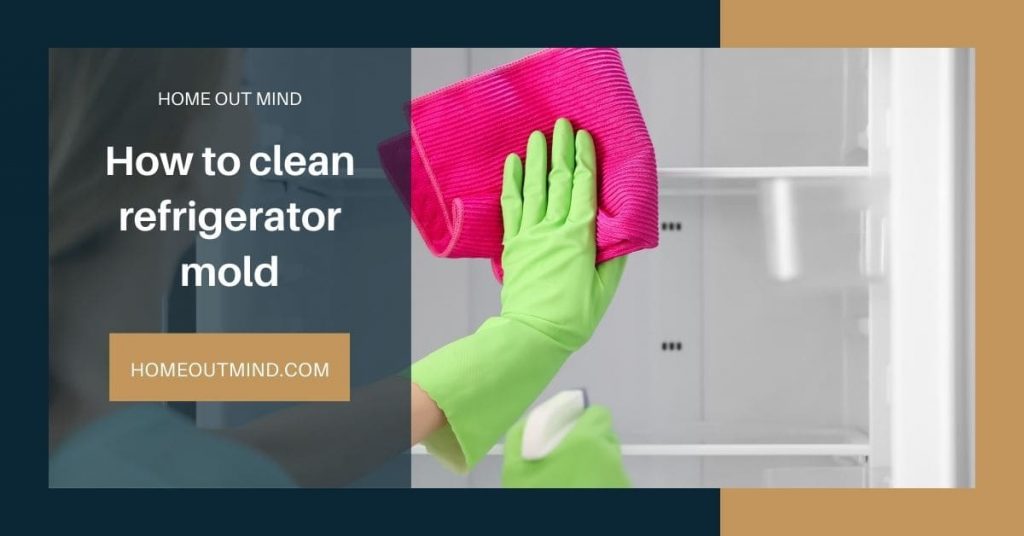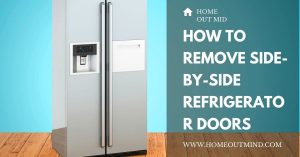Are you questioning how to clean refrigerator mold? Is your fridge full of mold and you don’t have any ideas about how to clean it? You’re in the right place where we’re going to explain how to clean fridge mold.
mold is microscopic and does manage to eventually get into everything. As a consequence, when you attempt to clean a refrigerator, use conventional and natural cleaners.
the existing mold within the refrigeration and ventilation system often remains thus, you end up essentially treating symptoms without the ability to fully abate the mold problem.
In this article we’ll show you how to clean refrigerator mold in two methods in method 1 we’ll show how to clean fridge mold with vinegar and lemon and in method2 we’ll show how to clean refrigerator mold with baking soda.

Method 1:
How to clean refrigerator mold with vinegar and lemon?
The largest concern is whether or not the mold has penetrated the fan and other interior components of the fridge.
Even with a high level of cleaning, unless you know that you can clean the interior components, you’re really just creating a cosmetic solution and the mold will come back.
Extremely acidic food-safe solutions and extremely basic food-safe solutions will both remove and eliminate mold. I’d suggest using vinegar to clean, as it’s usually the cheapest and easiest way, but you are welcome to use whatever is handy.
Items you will need method1:
- Vinegar
- Lemon
- Soft cloth
- Spray bottle
Step1. Take a lemon and cut a half and squeeze it in the spray bottle.
Step2. Take your vinegar and fill it in your spray bottle.
Step3. Mix the vinegar and lemon in your spray bottle.
Step4. empty the fridge of all contents (foods, beverages, bags…)
Step5. Remove shelves and drawers.
Remove shelves and drawers to have a free area to clean comfort and to get access to clean the entire fridge.
Step6. spray everything down with vinegar and lemon spray.
Step4. Wash shelves and drawers
Put the shelves and drawers in your sink or dishwasher and use soap and sponge and wash them with your hands and water make sure to clean them properly.
Step5. Clean refrigerator
Use a soft cloth and clean and dry the vinegar and lemon that you’ve added to your fridge top to bottom left to right starting with the door.
don’t worry if you can’t keep to the top-to-bottom left-to-right system it’s a very small space to get into so it won’t make that much difference but as long as you try and keep top to bottom to move all the dirt down and then once it’s down there you can move it out the lip of the fridge onto a cloth.
Step6. replace the drawers and all the shelves.
make sure they’re completely dry before you put them back in if you put them in wet they will probably freeze.
Step7. Put back your contents (foods, beverages, bags…)
Method2.
How to clean refrigerator mold with baking soda?
Items you will need in method2:
- rubber gloves
- baking soda
- paper towels
- a sponge with a nice scrubby side
- a mild cleaner which is just 2 tablespoons of dish detergent (like dawn or ivory)
step1. put on gloves.
Step2. Take all the drawers and shelves out.
Step3. Wash them individually with hot (almost boiling, might want gloves) soapy water. Let dry.
Step4. Peel baking soda flap
take your baking soda and let’s just peel this back a little you want it to be able to come out nice and easily.
Step5. Sprinkle baking soda.
take your baking soda and just sprinkle it all over your dirty refrigerator.
Step6. Scrub in baking soda.
start rubbing it in with the back of your scrubby sponge and you can see baking soda works really nicely the dirt will start coming off and mold right away it’s nice and scrubby.
once you’ve finished scrubbing down with your baking soda
step7. Spray the surface
take your soapy water and just spray down the surface of the refrigerator that you’re cleaning you want to get it nice and wet.
Step8. Wipe with a paper towel.
take your paper towels pull off a couple and just wipe down.
Once you’ve cleaned your fridge.
Step9. Reinstall the shelves and drawers in your fridge.
Make sure they are dry before you install them.
How do you get rid of black mold in the refrigerator?
Clean the affected area with a clean, wet sponge or cloth. This will remove most of the gross black mold.
Be sure not to rub the black stuff into the surface of the refrigerator, but rather gently mop it up.
Wash the sponge every time the surface looks black, or else you will only be spreading the mold spores all over the refrigerator surface.
Once most of it has been removed with the wet sponge, wipe the affected surface with a sponge/cloth that is soaked in hydrogen peroxide solution ( 1 to 3% solution).
This acts as bleach and “oxidizes” the mold and kills it. The surface may still look a little dark, but at least you would have stopped the growth of the mold.
Then you wipe the affected surface with a sponge/cloth that is soaked in a baking soda solution.
This will neutralize any acidic stuff left on the surface, and also take away any odor/smell from the refrigerator.
Finally, clean the affected surface with a clean, dry cloth or sponge.
Now you have treated the black mold that was already there in the refrigerator.
Get in the habit of cleaning the inside surface of the refrigerator regularly, once a month, with a clean wet cloth soaked in baking soda, and then a dry cloth. This will prevent the further formation of black mold – mostly.
Your refrigerator is a space where you store food that you eat.
Do not treat it like a dumping ground for uneaten food. Clean the fridge at least weekly, and purge any prepared food in there that has not been eaten for 3 days.
This will also help to keep your refrigerator sanitary and clean-smelling.
Can moldy food in the fridge contaminate other food?
Molds can and will contaminate the refrigerator Some species live and grow down to 33 degrees albeit slowly. So will bacteria – at even lower temperatures.
You may think most bacteria wouldn’t survive the icy conditions of a freezer. But they can. Bacteria and viruses such as listeria, E-coli, and salmonella can live in freezing temperatures, meaning they may be alive in your ice cubes.
As soon as temperature moderates mold and bacteria resume growth as if time was stopped and restarted.
Think about that the next time you stand in front of an open freezer or refrigerator door.
Air is circulating by convection throughout the box contaminating all surfaces with mold and bacteria. Every time you open the freezer or fridge door you start them growing again.
All those leftovers you tightly covered were sitting out in the air before you put them in the refrigerator so they are contaminated with everything airborne in the house. That is why there is a shelf life for anything you put in a refrigerator.
Covers are actually meant to stop water evaporation from the food ( air in the fridge has low relative humidity).
How to protect your food from mold?
You now know how toxic mold is once it gets into your food. So as of today, begin using zip log bags with dates written on each item you wish to refrigerate. That way, you know each item is in a protected and sealed environment of its own.
make sure you check each bag once you open, close, and leave it in the refrigerator each and every time without exception.
That way, you don’t and Will Not Ever run the risk of being fatally exposed again from a carelessly opened zip lock bag or perhaps a Tupperware-style plastic storage container.
Zip Lock Bags should only be used maybe Twice or Thrice at best
you can wash zip lock bags and plastic storage containers with a reputable dishwasher detergent such as (Cascade).
the detergent does not leave a detergent taste in the plastic, as dishwasher detergent uses more of an enzyme approach to clean dishes and plastics.



